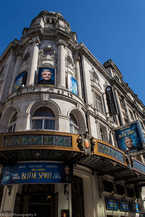Gielgud Theatre
William George Robert Sprague
alias Globe Theatre, Hicks TheatreGielgud Theatre | |
| show on the map | http://www.delfontmackintosh.co.uk/Theatres/gielgud_theatre.asp |
Important events
People
It is perhaps not generally realized that almost all of London's superbly intimate turn-of-the-century playhouses were designed by one man; Sprague was the architect of Wyndham's (1899), the Albery (1903; see colour plate Vi), the Strand (1905), the Aldwych (1905), the Globe (1906), the Queen's (1907), the Ambassadors (1913) and the St Martin's (1916). He also designed several other theatres in the London area, most of which have been destroyed. The Coronet (1898), now the Gaumont Cinema in Netting Hill Gate, and the Camden (1901) in Camden Town still survive, though under threat of demolition. The Edward VII in Paris, though apparently extremely French, was also designed by Sprague.
In: Glasstone, Victor: Victorian and Edwardian Theatres: An Architectural and Social Survey. Harvard 1975 p. 104
More theatresHistory
The Globe is separated from its twin, the Queen's, by a commercial block with shops. Although the two theatres were externally identical, inside Sprague manifested his virtuosity. The Globe's predominant Baroque-classicism is married to Georgian. The stage boxes were unfortunately reshaped in 1930, when 'modernistic' light-fittings were installed; however, the damage was slight. The sense of enveloping decoration is still dynamic. By enriching the wall surfaces behind the spectators, the architect avoids the great areas of bleakness so disturbing in most post-war theatres. Knowing what to do with a wall is the essence of the traditional theatre; the audience, when surrounded by itself and by decoration, seems to focus its attention on the stage. This apparent paradox, which has nevertheless been demonstrated time and time again, creates the 'theatrical atmosphere' which exists in these brilliantly vivacious auditoria. Apart from the incongruous light-fittings, the foyer is a worthy entrance to the theatre: a beautiful example of an architect supremely confident in his handling of space and decoration. By opening up the ground-floor ceiling into the first-floor saloon, a sense of great spaciousness has been created in what is in fact a very small area.
In: Glasstone, Victor: Victorian and Edwardian Theatres: An Architectural and Social Survey. Harvard 1975 p. 109
Opened as the Hicks Theatre 27 December 1906 with a transfer from the Aldwych Theatre of The Beauty of Bath, a musical play by Seymour Hicks and Cosmo Hamilton, lyrics by Charles H. Taylor and music by Herbert E. Haines. Produced by Seymour Hicks under the management of Charles Frohman. THE BUILDING In April 1904 it was announced that Jack Jacobus, the owner of a shoe¬maker's establishment in Shaftesbury Avenue, had acquired, in associa¬tion with Sydney Marler, an estate agent, from the almoners of Christ's Hospital an eighty-year building lease at a rent of £700 per annum, of a site including numbers 35-49 (odd) Shaftesbury Avenue. They also bought seventeen houses in Wardour Street, Rupert Street and Upper Rupert Street (now Winnet Street). The intention was to enlarge Jacobus's premises and to build two theatres on the site. This is the land on which arose the Hicks, now the Globe, Theatre and the Queen's Theatre. The Hicks, at the Rupert Street corner, was the first to be completed; the Queen's did not open until October 1907.
The architect for the whole scheme was W. G. R Sprague, who designed the two theatres with similar elevations. The Hicks Theatre was built by Charles Frohman and Seymour Hicks, in association with the Jacobus-Marler Estates, Ltd. The same group with J. E. Vedrenne in place of Frohman were responsible for the Queen's. The builder of both theatres was Walter Wallis of Balham. The Hicks, a two-tier theatre, the gallery rising behind the upper circle, its decorations of the Louis Seize period, in Rose du Barri with ivory and gold enrichments, was rechristened the Globe in July 1909. There had been another Globe Theatre in modern times in Newcastle Street; this was shut in 1902 and swept away in the Aldwych improve¬ments (see No. 2). Today, apart from redecoration, the removal of the boxes at the rear of the circle and the reshaping of the stage boxes in 1930, and the recent conversion of the gallery into a balcony by the addition of tip-up seats, the theatre remains the same.
In: Mander, Raymond a Mitcheson, Joe. The theatres of London.London, 1963 p. 90-91
Authors: Victor Glasstone, Raymond Mander
Victor Glasstone:
Criterion Theatre, Playhouse Theatre, King's Theatre, Shaftesbury Theatre, Globe Theatre, Aldwych Theatre, Hippodrome, Wyndham's, The Royal Pavilion Theatre, Gielgud TheatreRaymond Mander:
Her Majesty's Theatre, Adelphi Theatre, London Palladium, Palace Theatre, Gielgud TheatreAdditional information
No information has yet been entered
Add information





